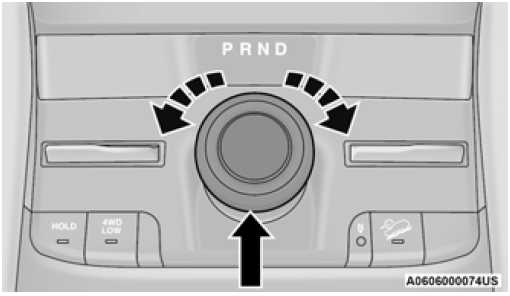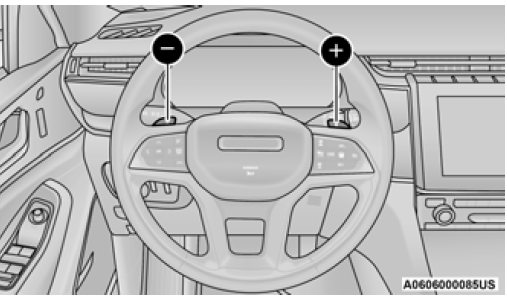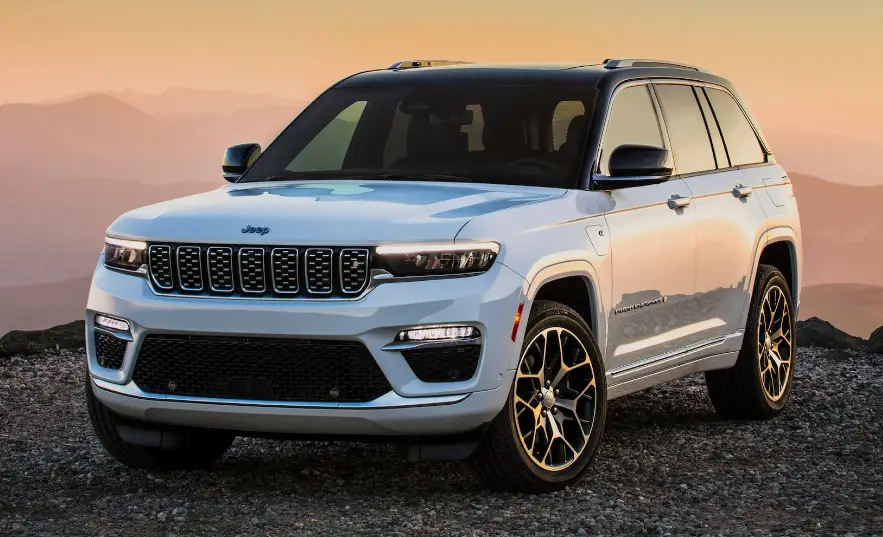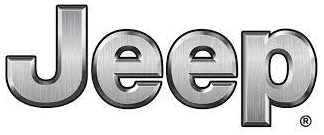2023 Jeep Grand Cherokee 4xe Transmission Guidelines
In the 2023 Jeep Grand Cherokee 4xe, there is a great mix of tough off-road power and cutting-edge hybrid technology. The transmission system is at the heart of its dynamic performance. The Grand Cherokee 4xe’s transmission guidelines stress that its electric and gasoline power sources should work together smoothly. These guidelines were made with accuracy and speed in mind. The new transmission switches between electric and hybrid modes smoothly, delivering the best amount of power for a responsive and fuel-efficient drive experience. In addition to saving fuel, this advanced transmission makes the vehicle more versatile. This means that the 2023 Jeep Grand Cherokee 4xe delivers a perfect balance of power and eco-friendly performance whether it’s driving on rough terrain or cruising through the city.
AUTOMATIC TRANSMISSION
You must press and hold the brake pedal while shifting out of PARK.
WARNING!
- Never use the PARK (P) position as a substitute for the parking brake. Always apply the parking brake fully when exiting the vehicle to guard against vehicle movement and possible injury or damage.
- Your vehicle could move and injure you and others if it is not in PARK. Check by trying to move the transmission gear selector out of PARK with the brake pedal released. Make sure the transmission is in PARK before exiting the vehicle.
- The transmission may not engage PARK if the vehicle is moving. Always bring the vehicle to a complete stop before shifting to PARK, and verify that the transmission gear position indicator solidly indicates PARK without blinking. Ensure that the vehicle is completely stopped, and the PARK position is properly indicated, before exiting the vehicle.
- It is dangerous to shift out of PARK or NEUTRAL (N) if the engine speed is higher than the idle speed. If your foot is not firmly pressing the brake pedal, the vehicle could accelerate quickly forward or in reverse. You could lose control of the vehicle and hit someone or something. Only shift into gear when the engine is idling normally and your foot is firmly pressing the brake pedal.
WARNING!
- Unintended movement of a vehicle could injure those in or near the vehicle. As with all vehicles, you should never exit a vehicle while the engine is running. Before exiting a vehicle, always come to a complete stop, then apply the parking brake, shift the transmission into PARK, and turn the ignition OFF. When the ignition is in the OFF position, the transmission is locked in PARK, securing the vehicle against unwanted movement.
- When exiting the vehicle, always make sure the ignition is in the OFF position, remove the key fob from the vehicle, and lock the vehicle.
- Never leave children alone in a vehicle, or with access to an unlocked vehicle. Allowing children to be in a vehicle unattended is dangerous for a number of reasons. A child or others could be seriously or fatally injured. Children should be warned not to touch the parking brake, brake pedal, or transmission gear selector.
- Do not leave the key fob in or near the vehicle (or in a location accessible to children), and do not leave the ignition in the ON/RUN position. A child could operate power windows, and other controls, or move the vehicle.
CAUTION!
Damage to the transmission may occur if the following precautions are not observed:
- Shift into or out of PARK or REVERSE (R) only after the vehicle has come to a complete stop.
- Do not shift between PARK, REVERSE, NEUTRAL, or DRIVE (D) when the engine is above idle speed.
- Before shifting into any gear, make sure your foot is firmly pressing the brake pedal.
IGNITION PARK INTERLOCK
This vehicle is equipped with an Ignition Park Interlock which requires the transmission to be in PARK (P) before the ignition can be turned to the OFF position. This helps the driver avoid inadvertently leaving the vehicle without placing the transmission in PARK. This system also locks the transmission in PARK whenever the ignition is in the OFF position.
NOTE:
The transmission will NOT shift out of the PARK position if the engine is not running even when the brakes are applied. Ensure that the transmission is in PARK, and the ignition is OFF (not in the ON/RUN position) before exiting the vehicle.
BRAKE/TRANSMISSION SHIFT INTERLOCK (BTSI) SYSTEM
This vehicle is equipped with a BTSI system that holds the transmission gear selector in PARK unless the brakes are applied. To shift the transmission out of PARK, the engine must be running and the brake pedal must be pressed. The brake pedal must also be pressed to shift from NEUTRAL into DRIVE or REVERSE when the vehicle is stopped or moving at low speeds.
8-SPEED AUTOMATIC TRANSMISSION
The transmission is controlled using a rotary electronic gear selector located on the center console. The transmission gear range (PRND) is displayed both above the gear selector and in the instrument cluster. To select a gear range, simply rotate the gear selector. You must press the brake pedal to shift the transmission out of PARK (or NEUTRAL, when the vehicle is stopped or moving at low speeds). To shift past multiple gear ranges at once (such as PARK to DRIVE), simply rotate the gear selector to the appropriate detent. Select the DRIVE range for normal driving.
NOTE:
In the event of a mismatch between the gear selector position and the actual transmission gear (for example, the driver selects PARK while driving), the position indicator will blink continuously until the selector is returned to the proper position, or the requested shift can be completed. The electronically controlled transmission adapts its shift schedule based on driver inputs, along with environmental and road conditions. The transmission electronics are self-calibrating; therefore, the first few shifts on a new vehicle may be somewhat abrupt. This is a normal condition, and precision shifts will develop within a few hundred miles (kilometers). Only shift from DRIVE to PARK or REVERSE when the accelerator pedal is released and the vehicle is stopped. Be sure to keep your foot on the brake pedal when shifting between these gears. The transmission gear selector has only PARK, REVERSE, NEUTRAL, and DRIVE positions. Manual downshifts can be made using the steering wheel-mounted paddle shifters. Pulling the -/+ switches (on the steering wheel) while in the DRIVE position will select the highest available transmission gear, and will display that gear limit in the instrument cluster as 1, 2, 3, etc. Some models will display both the selected gear limit and the actual current gear, while in AutoStick mode.
Transmission Gear Selector
Gear Ranges
Do not press the accelerator pedal when shifting from PARK (P) or NEUTRAL (N) into another gear range.
NOTE:
After selecting any gear range, wait a moment to allow the selected gear to engage before accelerating. This is especially important when the engine is cold.
PARK (P)
This range supplements the parking brake by locking the transmission. The engine can be started in this range. Never attempt to use PARK while the vehicle is in motion. Apply the parking brake when exiting the vehicle in this range. When parking on a hill, apply the parking brake before shifting the transmission to PARK. As an added precaution, turn the front wheels toward the curb on a downhill grade and away from the curb on an uphill grade.
When exiting the vehicle, always:
- Apply the parking brake.
- Shift the transmission into PARK.
- Turn the ignition OFF.
- Remove the key fob from the vehicle.
NOTE:
On four-wheel drive vehicles be sure that the transfer case is in a drive position.
CAUTION!
- Before moving the transmission gear selector out of PARK, you must start the engine and press the brake pedal. Otherwise, damage to the gear selector could result.
- DO NOT race the engine when shifting from PARK or NEUTRAL into another gear range, as this can damage the drivetrain.
The following indicators should be used to ensure that you have properly engaged the transmission into the PARK position:
- When shifting into PARK, rotate the shifter all the way counterclockwise until the indicator displays PARK.
- Look at the transmission gear position display and verify that it indicates the PARK position (P), and is not blinking.
- With the brake pedal released, verify that the gear selector will not move out of PARK.
REVERSE (R)
This range is for moving the vehicle backward. Shift into REVERSE only after the vehicle has come to a complete stop.
NEUTRAL (N)
Use this range when the vehicle is standing for prolonged periods with the engine running. Apply the parking brake and shift the transmission into PARK (P) if you must exit the vehicle.
WARNING!
Do not coast in NEUTRAL and never turn off the ignition to coast down a hill. These are unsafe practices that limit your response to changing traffic or road conditions. You might lose control of the vehicle and have a collision.
CAUTION!
Towing the vehicle, coasting, or driving for any other reason with the transmission in NEUTRAL can cause severe transmission damage.
For Recreational Towing see Ú page 174.
For Towing A Disabled Vehicle see Ú page 288.
DRIVE (D)
This range should be used for most city and highway driving. It provides the smoothest upshifts and downshifts, and the best fuel economy. The transmission automatically upshifts through all forward gears. When frequent transmission shifting occurs (such as when operating the vehicle under heavy loading conditions, in hilly terrain, traveling into strong headwinds, or while towing a heavy trailer), use the AutoStick shift control to select a lower gear Ú page 118. Under these conditions, using a lower gear will improve performance and extend transmission life by reducing excessive shifting and heat buildup. During cold temperatures, transmission operation may be modified depending on engine and transmission temperature as well as vehicle speed. This feature improves the warm-up time of the engine and transmission to achieve maximum efficiency. Engagement of the torque converter clutch is inhibited until the transmission fluid is warm. Normal operation will resume once the transmission temperature has risen to a suitable level.
Transmission Limp Home Mode
Transmission function is monitored electronically for abnormal conditions. If a condition is detected that could result in transmission damage, Transmission Limp Home Mode is activated. In this mode, the transmission may operate only in certain gears, or may not shift at all. Vehicle performance may be severely degraded and the engine may stall. In some situations, the transmission may not re-engage if the engine is turned off and restarted. The Malfunction Indicator Light (MIL) may be illuminated. A message in the instrument cluster will inform the driver of the more serious conditions, and indicate what actions may be necessary.
In the event of a momentary problem, the transmission can be reset to regain all forward gears by performing the following steps:
NOTE:
In cases where the instrument cluster message indicates the transmission may not re-engage after engine shutdown, perform this procedure only in a desired location (preferably, at an authorized dealer).
- Stop the vehicle.
- Shift the transmission into PARK (P), if possible.
If not, shift the transmission to NEUTRAL (N). - Push and hold the ignition switch until the engine turns off.
- Wait approximately 30 seconds.
- Restart the engine.
- Shift into the desired gear range. If the problem is no longer detected, the transmission will return to normal operation.
NOTE:
Even if the transmission can be reset, we recommend that you visit an authorized dealer at your earliest possible convenience. An authorized dealer has diagnostic equipment to assess the condition of your transmission. If the transmission cannot be reset, authorized dealer service is required.
AutoStick — If Equipped
AutoStick is a driver-interactive transmission feature providing manual shift control, giving you more control of the vehicle. AutoStick allows you to maximize engine braking, eliminate undesirable upshifts and downshifts, and improve overall vehicle performance. This feature can also provide you with more control during passing, city driving, cold slippery conditions, mountain driving, trailer towing, and many other situations.
AutoStick Paddle Shifters
Operation
To activate AutoStick mode, tap one of the paddle shifters on the steering wheel. Tapping the (-) paddle shifters to enter AutoStick mode will downshift the transmission to the next lower gear while tapping (+) to enter AutoStick mode will retain the current gear. The current transmission gear will be displayed in the instrument cluster. In AutoStick mode, you can use the paddle shifters, to manually shift the transmission. Tapping the (-) paddle shifters will downshift the transmission to the next lower gear. Tapping the (+) paddle shifters will upshift the transmission to the next highest gear.
In AutoStick mode, the transmission will shift up or down when (+/-) is manually selected by the driver, unless an engine lugging or overspeed condition results.
FAQs
A: The 2023 Jeep Grand Cherokee 4xe features an automatic transmission.
A: The transmission in the 2023 Jeep Grand Cherokee 4xe is an 8-speed automatic.
A: Yes, the transmission is electronically controlled for optimized performance.
A: No, the 2023 Jeep Grand Cherokee 4xe is only available with an automatic transmission.
A: The towing capacity can vary, but with the proper equipment, it is expected to be competitive in its class.
A: Yes, the 2023 Jeep Grand Cherokee 4xe typically offers multiple driving modes that can influence transmission behavior.
A: Yes, the transmission is designed to complement the Grand Cherokee’s off-road performance.
A: The 8-speed automatic transmission is designed to balance performance and fuel efficiency through optimal gear ratios.
A: Yes, the transmission typically offers a manual shift mode for more control over gear selection.
A: Warranty coverage can vary, but it often includes a limited warranty for the transmission.
A: Some models may come with safety features such as adaptive cruise control and automatic emergency braking, which can be related to the transmission system.
A: The recommended intervals for transmission fluid changes can vary, so it’s essential to refer to the owner’s manual for specific guidelines.
A: The transmission can typically be serviced at authorized Jeep dealerships and certified service centers.
A: It’s advisable to check for any manufacturer recalls or reported issues, although newer models tend to have fewer problems.
A: The transmission, with its automatic and manual capabilities, plays a significant role in delivering a smooth and responsive driving experience, both on and off the road.
Useful Link
View Full PDF: 2023 Jeep Grand Cherokee 4xe | Auto User Guide


